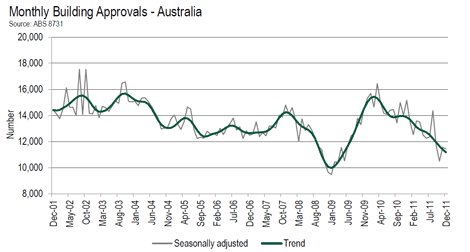Queensland building approvals up 25%, but national approvals fall: ABS
There was a notable pick-up in Queensland building approvals in December, bucking a weaker-than-expected national decline of 1%, according to the latest ABS figures.
Coinciding with improved take-up of the state’s $10,000 building boost (the scheme has been extended to April), Queensland building approvals increased by 24.6% in December on a seasonally adjusted basis, with Tasmania (15.6%) and Western Australia (6.0%) the other states to record increases.
The weakest state was Victoria (-16.7%) followed by South Australia (-9.1%) and New South Wales (-5.0%).
Approvals for private sector houses rose 0.2% in December, with rises in Western Australia (6.3%) and Queensland (4.7%), while South Australia (-8.3%), New South Wales (-3.7%) and Victoria (-3.4%) fell.
The value of total building approved increased 1.9% in December following a decrease of 0.5% in November. The value of residential building increased 1% while non-residential building rose 3.3%.
Westpac says headline approvals “were a touch weaker than expected” but in line with the consensus and its own forecasts once revisions are made.
The bank expects national approvals to be revised up to a 2% rise in the month.
“Approvals were down 1% in December, but November's 8.4% bounce was marked up to 10.1% for the month,” the bank says.
“The context is important. Approvals were very volatile in the months before November, with sharp falls in Sep (–18.7%mth) and Oct (–10.1%mth). Despite the upwardly revised November bounce, approvals are still down nearly a quarter on December 2010.
“However there are signs that the rate of decline is moderating,” it says.
Predictably, the Housing Industry Association called for more government stimulus following the decline in December.

Source: HIA
“Building approvals for both detached houses and ‘other dwellings’ are at very weak levels and now is the time to further lower interest rates and implement fiscal stimulus measures,” says HIA chief economist Harley Dale.
“Building approvals in late 2011 imply that housing starts will fall to a level below that experienced during the depth of the GFC, which would clearly be a very unhealthy outcome,” Dale says.
“The new home building sector is a key indicator of the health of the domestic economy and has a significant multiplier effect in terms of output and employment.”
“New housing activity doesn’t need to fall further, that situation can be averted. Such aversion requires further interest rate cuts starting next week, full pass through of those rate cuts by the banks, and government measures to both stimulate new home building activity and reignite action to address the high and inefficient tax base which applies to new housing.”